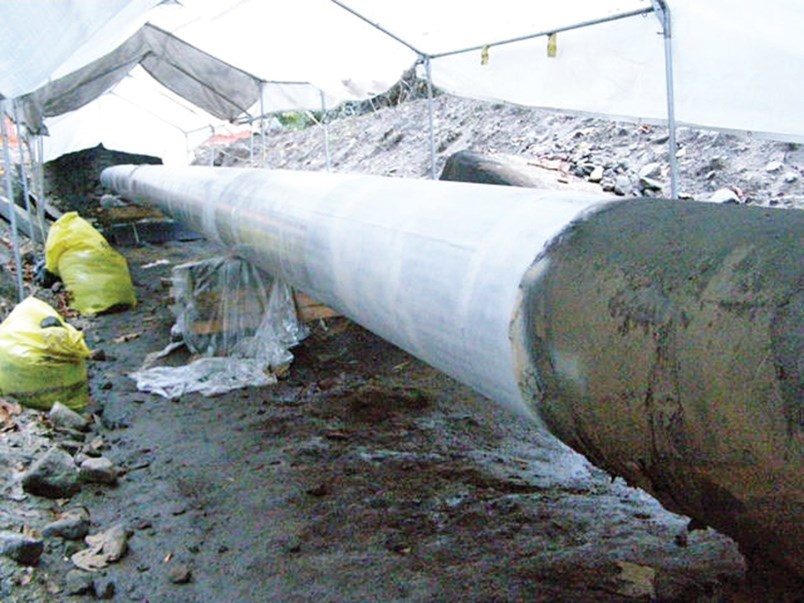Kinder Morgan Canada relied on maps from the city’s website when creating its pipeline route through the municipality, the National Energy Board learned this week.
“The information that we’ve used in our mapping, I can provide the reference to the City of Burnaby’s website where our information was taken from,” said Michael Davies, the company’s vice-president of operations on Tuesday.
The NEB is holding oral hearings into Kinder Morgan’s proposed route for its $7.4-billion Trans Mountain expansion project until Jan. 31. It allows the board to hear from affected landowners (like the City of Burnaby) who have issues with the route.
Mapping came up many times during the meetings this week, especially around the Brunette River Conservation Area (BRCA), where the pipeline is proposed to go through.
Greg McDade, part of Burnaby’s legal counsel, asked Davies whether the company had known the route would run through the BRCA when it submitted its application to the NEB.
“Burnaby’s intent to include that land in a conservation area was not clear to us in the routing process. We’ve dealt with the landowner, which is BNSF Railways. We’ve relied on mapping from the City of Burnaby and we’ve attempted to engage with Burnaby on routing-type issues throughout the course of the project. And I think, as the record shows ... that process, engaging with Burnaby, has not always been very effective,” said Davies.
He added that maps, ones from the ’80s, showed “an intent that this might become part of a conservation area, but the lands are not designated as such in Burnaby’s current mapping.”
“When we picked this route, we’ve endeavoured to be around the north side of the railway where it’s away from the conservation area,” said Davies, noting the portion of the pipeline that goes through the BRCA follows a jet fuel line and power line.
Jim Wolf, a senior long-range planner with the city, said Burnaby’s online maps have “various layers” of information that include city lands, park boundaries and official community plan land designations. However, not all layers are released to the public.
“When we publish documents that are meant for the public to go walking in our park spaces, we want to make sure that they’re walking on safe, travelled and approved trails, and not on private property,” Wolf explained during cross-examination.
“The Brunette Conservation Area and many of our other parks include private properties. Private properties can be within an approved park or conservation boundary, but they may not be displayed that way for a public document because we don’t want to mislead the public into walking into spaces that are still under private control and ownership,” he said.
Kinder Morgan staff made an error in selecting a layer that only showed city-owned park parcels, which omitted the actual boundaries of the Brunette River Conservation Area, according to Wolf.
In an emailed statement from Trans Mountain, the company said: “In general, our process is to acquire publicly available information, including mapping, and then continue to refine this information in cooperation with municipalities, landowners and stakeholders. We were unable to have constructive conversations with the City of Burnaby to help refine the information we found online.”
Burnaby also sparred with Kinder Morgan over its consultation process with the community, arguing there was little to no consultation.
“When I say that not once was a public meeting held in Burnaby for all residents to attend freely, I’m quite serious. We do not consider meetings held in Coquitlam to be part of an engagement with the City of Burnaby.
“We are the third-largest municipality in the province of B.C., and we are the end of the line of this project. And we are carrying a massive burden under this proposal. And I would have thought that that project would have determined that they would have done an extra-special effort within our community because not only did we – we’re getting bigger facilities – but we’re getting an entirely new pipeline through our community,” said Wolf.
According to Lexa Hobenshield, Kinder Morgan Canada’s external relations manager, the company held two routing workshops for Burnaby residents; the first one was on June 26, 2013 at the Executive Hotel on Lougheed Highway.
“For that workshop, rather, stakeholders from Burnaby were invited to represent community organization interests. The City of Burnaby was invited to participate in that workshop and chose to decline,” she said.
An open house was held the following day for Burnaby residents who may have not been invited to the previous one.
“Following that, we invited online input for three weeks,” Hobenshield said, noting the company advertised through social media and in local papers. The second workshop was held on April 4, 2014 in Coquitlam, at the Executive Hotel and Conference Centre.
Kinder Morgan maintained, again, it tried to engage with the City of Burnaby but was unsuccessful.
NEB spokesperson James Stevenson told the NOW once a detailed route hearing ends, it usually takes between two to three months for a decision. (There will be another round of hearings in Burnaby in March.)
The federal government approved the Trans Mountain project in November 2016, on the recommendation of the NEB. The national energy regulator attached 157 conditions to its approval.
The oral hearings are not meant to debate the NEB’s approval; instead, they determine exactly where the route will be within the approved corridor.
In total, there have been more than 4,600 pages of evidence, reply evidence and other filings for Segment 7 of the route (which includes Burnaby).
The NEB has the power to approve the route in segments, so if Segment 7 isn’t granted, Kinder Morgan would need to go back to the drawing board.



